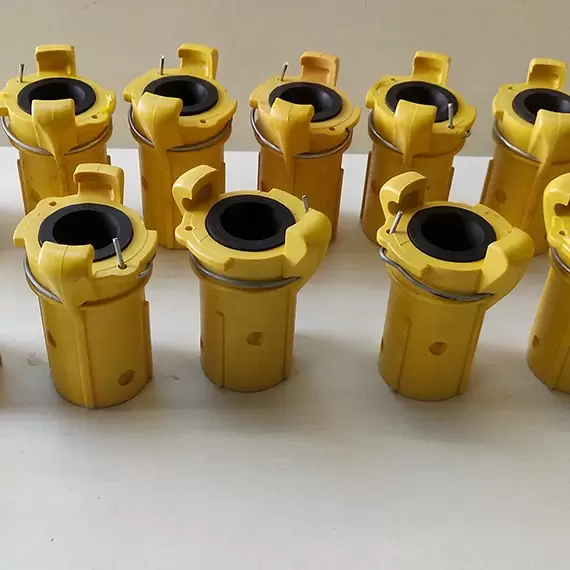Abrasive Blasting Hose Coupling
An abrasive blasting hose coupling is a type of connector that attaches an abrasive Sand blasting hose to a sandblasting nozzle or other equipment. It is designed to withstand the high-pressure and abrasive nature of the blasting process, and typically has a locking mechanism to prevent accidental disconnection during use.
Abrasive blasting, also known as sandblasting, involves the use of a high-pressure stream of abrasive material (such as sand, steel shot, or glass beads) to clean, strip, or shape a surface. The blasting hose is a critical component of the equipment used in this process, and the coupling serves as a secure connection point between the hose and other components.
Abrasive blasting hose couplings are typically made of durable materials such as brass, aluminum, or stainless steel, and come in a variety of sizes and styles to fit different hose and nozzle configurations. It is important to select the correct coupling for the specific application to ensure safe and effective operation.
Uses of Abrasive Blasting Hose Couplings
- Connection of Hoses: The primary use of abrasive sand blasting hose couplings is to connect abrasive blasting hoses to the blasting equipment, such as the blasting pot, pressure vessel, or blast machine. They provide a secure and reliable connection that allows the abrasive media to flow smoothly from the equipment to the blasting nozzle.
- Hose Extension and Repair: Abrasive sand blasting hose couplings can also be used to extend or repair blasting hoses. By connecting multiple hoses or replacing damaged sections, operators can achieve the desired hose length and maintain the integrity of the blasting system.
- System Customization: The couplings enable customization and flexibility in the design of blasting systems. They allow for the connection of various components, such as different types of hoses, nozzle holders, blast pots, and other blasting accessories, to create a tailored setup that meets specific application requirements.
- Equipment Maintenance: sand blasting hose couplings facilitate routine maintenance and inspection of the blasting equipment. They allow for easy detachment of hoses, enabling operators to clean, inspect, or replace worn-out parts as needed to ensure optimal performance and longevity of the equipment.
Features of Abrasive Blasting Hose Couplings
- Robust Construction: Abrasive blasting hose couplings are typically made of durable materials such as brass, aluminum, or stainless steel to withstand the harsh conditions of abrasive blasting. They are designed to resist corrosion, abrasion, and wear caused by the abrasive media and environment.
- Secure Connection: The couplings feature a threaded or quick-connect mechanism that allows for a tight and secure connection between the hose and the blasting equipment. This ensures that the abrasive media flows without leaks or interruptions, maximizing the efficiency of the blasting process.
- Compatibility: Abrasive blasting hose couplings are available in various sizes and types to accommodate different hose diameters and connection requirements. They are designed to be compatible with standard blasting hoses and fittings, allowing for easy integration into existing blasting systems.
- Easy Installation and Removal: The sand blasting couplings are designed for quick and easy installation and removal, enabling efficient setup and teardown of the blasting equipment. This facilitates maintenance, replacement, and reconfiguration of the hoses as needed.
- Safety Features: Some abrasive blasting hose couplings may incorporate safety features such as locking mechanisms or safety pins to prevent accidental disconnection during operation. These features help ensure the operator's safety and prevent injuries caused by hose detachment or sudden release of pressure.
- Pressure Rating: Abrasive blasting hose couplings are designed to withstand the high-pressure conditions of abrasive blasting systems. They are rated for specific working pressures to ensure reliable and safe operation without the risk of coupling failure or leakage.
Related Products

Blasting Nozzle
A blasting nozzle, also known as a sand blasting nozzle or abrasive blasting nozzle, is a tool used in the process of blasting or cleaning a surface with high-pressure air or water and abrasive material such as sand, glass beads, steel shot, steel grit, silicon carbide or plastic particles.
Rs 20000
Rs 40000

Sand Blasting Nozzle Holder
A Sand Blasting Nozzle Holder is a device used to secure a sand blasting nozzle onto a sand blasting gun or baton. The holder is typically made of a durable material such as aluminum or steel and is designed to withstand the high-pressure and abrasive nature of the sand blasting process.
Rs 400
Rs 300

Sand Blasting Hose
A sand blasting hose is a flexible tube used to connect sand blasting equipment, such as a sand blasting gun, to a source of compressed air or other power supply. The hose is designed to withstand the high-pressure and abrasive nature of the sand blasting process, which involves propelling abrasive
Rs 400
Rs 700

Pinch Valve
A pinch valve is a type of valve used to control the flow of fluids or gases through a pipeline or other conduit. It operates by using a flexible sleeve or tube, typically made of rubber or other elastomeric material, that is pinched or compressed by a mechanism to shut off or regulate the flow of t
Rs 2400
Rs 2500






